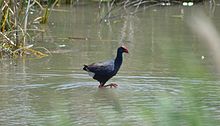Porphyrio porphyrio
| Western swamphen | |
|---|---|
 |
|
|
Not recognized (IUCN 3.1)
|
|
| Scientific classification | |
| Kingdom: | Animalia |
| Phylum: | Chordata |
| Class: | Aves |
| Order: | Gruiformes |
| Family: | Rallidae |
| Genus: | Porphyrio |
| Species: | P. porphyrio |
| Binomial name | |
|
Porphyrio porphyrio (Linnaeus, 1758) |
|
| Synonyms | |
|
Porphyrio coeruleus |
|
Porphyrio coeruleus
The western swamphen (Porphyrio porphyrio) is a "swamp hen" in the rail family Rallidae. From its French name talève sultane, it is also known as the sultana bird. This chicken-sized bird, with its large feet, bright plumage and red bill and frontal shield is easily recognisable in its native range. It used to be considered the nominate subspecies of the purple swamphen. It is found in Iberia, France, Sardinia and North Africa to Tunisia.
The species makes loud, quick, bleating and hooting calls, which are hardly bird-like in tone. It is particularly noisy during the breeding season. Despite being clumsy in flight it can fly long distances, and it is a good swimmer, especially for a bird without webbed feet.
Western swamphens are generally seasonal breeders, correlating with peak rainfall in many places, or summer in more temperate climes. The purple swamphen breeds in warm reed beds. The pattern of social behaviour tends to be monogamy.
Pairs nest in a large pad of interwoven reed flags, etc., on a mass of floating debris or amongst matted reeds slightly above water level in swamps, clumps of rushes in paddocks or long unkempt grass. Each bird can lay 3–6 speckled eggs, pale yellowish stone to reddish buff, blotched and spotted with reddish brown. The incubation period is 23–27 days, and is performed by both sexes. The precocious chicks are feathered with downy black feathers and able to leave the nest soon after hatching, but will often remain in the nest for a few days. Young chicks are fed by their parents (and group members) for between 10–14 days, after which they begin to feed themselves.
The western swamphen prefers wet areas with high rainfall, swamps, lake edges and damp pastures. The birds often live in pairs and larger communities. It clambers through the reeds, eating the tender shoots and vegetable-like matter. They have been known to eat eggs, ducklings, small fish and invertebrates such as snails. They have even been known to attack large eels; however, there is no consensus amongst ornithologists if they actually eat eel. They will often use one foot to bring food to their mouth rather than eat it on the ground. Where they are not persecuted they can become tame and be readily seen in towns and cities.
...
Wikipedia
